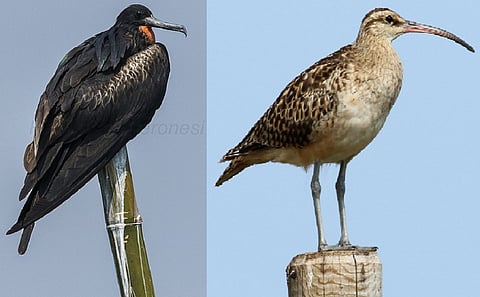

Birds with the most distinctive or unique characteristics on the planet are also the most threatened ones, a new study has found. The threat can have severe consequences on the functioning of ecosystems.
The extinction of species disturbs their unique role in the environment and directly affects the functioning of ecosystems, also known as functional diversity. The primary roles of bird species are seed dispersal, predation and pollination.
The study was led by researchers at the Imperial College London (ICL) and its findings are published in the British Ecological Society journal Functional Ecology.
The researchers studied datasets of measurements gathered from living birds and museum specimens — a collection of 9,943 bird species. The scientists looked at physical traits and characteristics like the length of wings, tail, legs and beak size and shape.
Christmas frigatebird (Fregata andrewsi) and the bristle-thighed curlew (Numenius tahitiensis) are morphologically unique birds that are also threatened, researchers found.
The bristle-thighed curlew migrates to South Pacific islands from its breeding grounds in Alaska every year, while the Christmas frigatebird (Fregata andrewsi) nests peculiarly on Christmas Island in the Indian Ocean.
The scientists referred to the International Union for Conservation of Nature (IUCN)’s Red List to identify the birds which are at risk of extinction and combined it with the morphological data. A simulation model was then prepared that helped analyse a scenario considering the threatened birds became extinct.
Other unique bird species at risk identified are Procellariiformes, Pelecaniformes, Struthioniformes, Galliformes, Tyrannidae, Falconiformes and Accipitriformes, among others.
The researchers observed that if all the threatened and near-threatened bird species went extinct in a simulated scenario, the possibility of reduction in the physical or morphological diversity among birds becomes significantly high compared to scenarios where extinctions were specific to a geographic area or random.
“Our study shows that extinctions will most likely prune a large proportion of unique species from the avian tree. Losing these unique species will mean a loss of the specialised roles that they play in ecosystems,” said lead author of the research Jerome Ali in a press statement.
Ali is a PhD candidate at Princeton University who conducted research at ICL, London.
The study also predicts that the current extinction crisis will target bird species whose loss will reduce the efficiency of their ecological services.
Functional ecosystems will dramatically collapse unless action is initiated to protect the threatened species and prevent their extinction, Ali warned.
“One possibility is that highly specialised organisms are less able to adapt to a changing environment, in which case human impacts may directly threaten species with the most unusual ecological roles,” the researcher further said.
More research is needed to delve deeper into the connection between unique traits and extinction risk, he added.